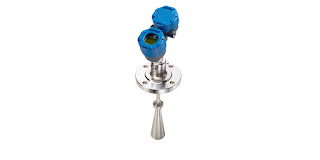 |
| Magnetrol TA2 thermal flow meter configured for insertion mounting. Image courtesy Magnetrol International |
One example of a thermal mass flow meter is a hot wire anemometer, with which air speed is measured via a metal wire charged with an electric current. The faster the air moves around the wire, the more the temperature of the wire will correspondingly drop. The electrical power required to keep the temperature of the wire constant is directly proportional to the flow rate of the air moving past the wire. However, thermal flow meters are inherently used to measure mass air flow and not volumetric air flow.
A common application of thermal flow meters is mass air flow measurement for combustion control, such as in engines and boilers. Maintaining fuel to air ratios in a range resulting in efficient combustion is essential to controlling fuel costs and the level of regulated emissions. Keeping combustion efficient relies on a controller’s ability to modify the combustion air mass flow rate to match the demand for fuel under changing load and input conditions. Thermal dispersion technology can be applied to gases or liquids, making the range of applications very broad.
Typically, thermal mass flow meters used in processing industries will have a flow tube or insertion probe with two temperature sensors, one which is heated and the other which is not. The heated sensor serves as the mass flow sensor, meaning it will cool at a rate directly dependent on mass flow. The purpose of the second temperature sensor is to deliver an accurate measure of fluid temperature. Various processing methods are employed to determine the degree of thermal dispersion, but all are related to the same basic principal.
One of the best applications for thermal mass flow meters is at a particular point of a flow stream, where the flow meter can be inserted or installed to measure a specific amount of fluid being used in the process, such as the amount of gas being sent to a flare. Their design simplicity and ease of production allows thermal flow meters to be very compact. Some are even coupled with built-in throttling mechanisms and other control devices, incorporating measurement and control functions into a single integrated device.
Share your flow measurement requirements and challenges with an instrumentation specialist, combining your own process knowledge and experience with their product application expertise to develop an effective solution.


